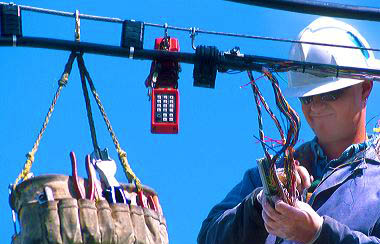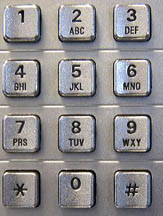Business
P.U.C. Should Hang Up On Landline Subsidy

Telephone lineman fixing the traditional telephone line.

Old-style phone cable required two copper wires for every connection.
The fund was created in 1988 to tax what used to be “The Phone Company.” Back in the day, the company affectionately known as “Ma Bell,” pretty much controlled telecommunications in Southern Idaho. Mountain States Telephone became Mountain Bell which became U.S. West which became Qwest which became Century Link which has lots of wires hanging on poles, but customers are switching to cell phone service and abandoning the landline.
And therein lies the problem. While revenue from the fund has declined from approximately $2 million in 2015 to $1.29 million in 2017, disbursements have held steady: The eight rural telephone carriers that are eligible for fund disbursements have received a total of $1,698,610 every year since 2013.
Absent an increase to the surcharges, the fund would not have been able to meet its obligations in the current fiscal year. It would seem that it is time for the PUC to disconnect, hang up, pull the plug on the subsidy to the small phone companies. With the proliferation of cell service–much of it offered by the small carriers receiving the landline subsidy–a case can no longer be made to have the traditional city users pay to provide phone lines to their country cousins.

Of course the irony is that more people will cut the cord and rely on cell phones as they realize they are paying to keep an outdated system alive, causing a further decline in subsidy revenues.
For the younger set, there was a time when the “Phone Company” provided free “0” for operator assistance which ranged from what we expect today when we call 911 to free “directory assistance” (dial 555-1212) anywhere in the USA and in some cases the world. You could dial a number and get the exact time to set your clock or watch: “At the tone the time will be…”

The numbered buttons on a “modern” pay phone. Try to find one today.
Calls to or from parents and grandparents were often cut short and ended with, “This is long distance, so I am gonna say goodbye now.” Long distance fees could rival today’s “unlimited plans” for cell service. If you called or received a call more than once in the same week the second call was often as not bad news, like a death in the family.
For the entire PUC press release, click.
Faced with declining revenue as Idahoans increasingly abandon land line phone service, state regulators have raised a monthly surcharge on land lines and questioned the sustainability of the Idaho Universal Service Fund (IUSF).
The fund was established in 1988 to ensure all Idahoans have access to local telephone service at reasonable rates.
This is accomplished by taking revenue collected from a surcharge on land-line users and long-distance call minutes, and distributing it to telecommunications carriers that meet eligibility requirements.
Over the last several years, however, revenue has been insufficient to cover distributions.
In the recently completed 2017 fiscal year, for example, the fund collected nearly a half-million dollars less than it distributed.
The trend prompted the Commission to raise the monthly surcharge on each residential line to 25 cents (the current surcharge is 12 cents), and to 44 cents for each business line (currently 20 cents), effective Sept. 1.
The cost for each minute of a long-distance call is set to increase too, from ½ cent per minute to 0.9 cents per minute.
The changes are expected to allow the fund to meet its obligations for the 2018 fiscal year, but the Commission expressed concern that raising the surcharge will cause more Idahoans to abandon their land lines, exacerbating the trend and eventually making the fund unsustainable.
To address this, the Commission opened a generic docket to facilitate communication with the general public, telephone company representatives and other stakeholders, with a goal of developing a sustainable approach for the fund in a declining industry where land lines are being replaced with new technology such as cell phones and Voice over Internet Protocol.
“We…find it prudent and necessary to take a hard look at the sustainability and viability of the IUSF,” the Commission said in its order.
The IUSF was created through the Idaho Telecommunications Act of 1988 with the goal of maintaining statewide availability of local phone service at reasonable rates in rural areas where the cost of providing service is more costly than in urban areas.
With assistance from the Universal Service Fund, rural telephone companies are able to keep their rates at no more than 25 percent above rates in more urban areas.
While revenue from the fund has declined from approximately $2 million in 2015 to $1.29 million in 2017, disbursements have held steady: The eight rural telephone carriers that are eligible for fund disbursements have received a total of $1,698,610 every year since 2013.
Absent an increase to the surcharges, the fund would not have been able to meet its obligations in the current fiscal year.
A full text of the commission’s order is available on the commission’s Web site at www.puc.idaho.gov. Click on “File Room” and then on “Telecommunications Cases” and scroll down to Case No. GNR-T-17-04.
To insure more advertising-free Boise Guardian news, please consider financial support.
 August 22, 2017
August 22, 2017 
Aug 22, 2017, 9:34 pm
Very informative. Thank you.
Aug 22, 2017, 9:49 pm
OMG I can remember all of that from being away for military and grad school.
Aug 22, 2017, 11:01 pm
How interesting, but not really alarming. Subsidies have been around for a long time and to do away with the land line might not be an optimum decision.
People gave up their land lines for portability as early as 1990, or so.
Robo-calls, and on the spot communication killed the land line, and now the predators on satellite communication are the robo-callers, too.
Dial out charges are possibly the only future of any communication set up.
That would save the valuable land line for many people. What is so old fashioned about a device you plug in to the wall, and use to talk to people from your home, (NOT WHILE DRIVING YOUR CAR)?
The communication industry is well beyond the average earners ability to keep up with it. If we’re not subsidizing land lines, it is something else.
Communication systems, like in firefighting radios, have to go to the lowest denominator to reach all. Why not subsidize the lowest, instead of the highest?
Technology push economy.
Aug 23, 2017, 12:08 am
There is little or no cell phone coverage in most of the areas that the small phone companies cover.
Aug 23, 2017, 7:01 am
I live 1.3 miles from the State House. My only access to the internet is via landline. Wireless connection is very, very poor and there is no access to a cable connection. TV is via antenna and internet.
Although landline use for phone service my be dwindling, there are other uses…just sayin’…
Aug 23, 2017, 8:09 am
Subsidies exist for one reason or another and getting rid of them can be difficult. Technology may help in this case, but Idaho still is pretty geographically diverse.
If this one is deemed worth keeping, make the big guys pay it. Just hide it in our bill by making us only pay for service instead of 5 line items that include service fee, taxes etc.
While we are getting rid of subsidies, how about the road subsidy too?
From pg26 of ACHD budget: “Property taxes remain the single largest General Fund revenue of the Highway District.” There is a nice graphic showing this too.
http://www.achdidaho.org/Departments/Administration/Docs/2017Budget/Final2017/Introduction_and_Summary.pdf
Aug 23, 2017, 9:09 am
How about the service charge of $5.00 on my Idaho Power bill or the 1.5% franchise fee which is used as a slush fund by the city. Gas company has similar charges. My usage is read and paid electronically but modern electronics have not lowered the fees.
Aug 23, 2017, 9:59 am
With digitization of everything telephone they have opportunities to cheat. As more customer calls pass through a cell tower they just simply electronically remove evenly spaced bits of the signal. This happens on modern landlines too, but just not as noticeably. So, Cell CEOs, there’s nothing wrong with my phone or my hearing. It’s you not me. The problem is you are only transmitting evenly spaced bits of my conversation. My analog brain knows it. In the good ol days on the old landlines the signal was pure and complete. Digital and fiber optic got rid of the hum and other fuzz but now use it to chop little bits from calls and therefore more $$$ per cable/tower.
Aug 24, 2017, 12:58 pm
Maybe if people spent as much time studying how to change cellular carriers for a better deal as they do worrying about the tiny universal service fee they’d come out way way ahead.
If you’re an average consumer still paying $50 or $60 a month for cellular, you’re getting gouged. Big Time Gouged. It’s easier than ever to shop around for cell service.
Currently Sprint is offering a 1 year free, no contract cell service, unlimited talk, text and data. You need to bring your own device and it needs to be compatible.
https://www.sprint.com/en/shop/offers/free-unlimited.html
About compatibility, If you can’t afford a brand new unlocked phone, there are good used deals. Beginning with iPhone 5, any iPhone from Verizon is factory unlocked out of the box forever. That means you can switch carriers at will keeping your same number. Switching and porting your number can be done in a matter of minutes online. Of course it’s a bit harder for a family of 12. All you need is a SIM card and they’re cheap or even free if you go to a “corporate” store. Those Verizon iPhones, beginning with the 5c are virtually universal. Meaning they’ll work on nearly any cellular carrier world wide. Similar “world phones” are available from Samsung and probably others. Many, possibly all, ATT and Tmobile iPhones can be unlocked and ported to any other GSM compatible carrier.
There are many many so called MVNOs available for monthly rates around $20/month. Freedom Pop has a $49/year plan. Virgin Mobile, a Sprint MVNO, is offering a $1/year plan for unlimited everything.
Shop around people, educate yourselves.
https://en.wikipedia.org/wiki/List_of_United_States_mobile_virtual_network_operators